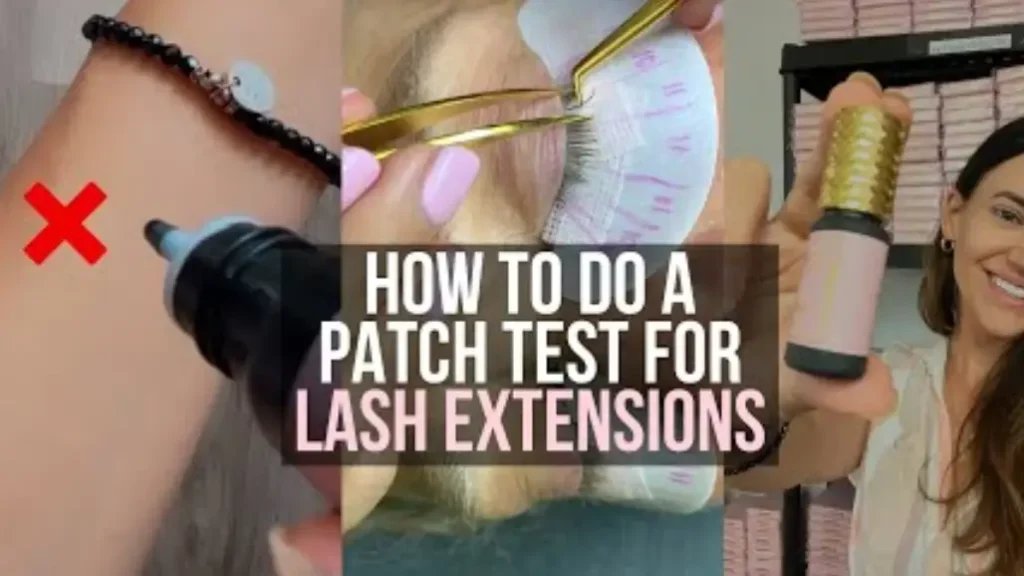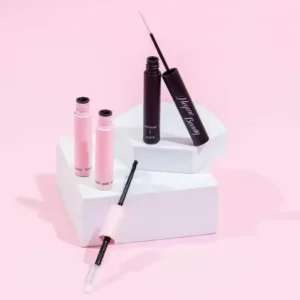![]()
Lash extensions can enhance your natural beauty and save you time on your daily makeup routine. However, it’s crucial to prioritize your eye health and safety. Before embarking on your lash extension journey, conducting a patch test is an essential step to rule out any potential allergies or sensitivities.
This blog post will guide you through the proper patch test procedure for lash extension glue. We’ll cover the importance of patch testing, how to perform the test correctly, and what to look for during the observation period. By following these simple steps, you can ensure a safe and enjoyable lash extension experience.
What is Patch Test for Lash Extensions

A patch test for lash extensions is a crucial safety measure designed to identify any potential allergies or sensitivities to the adhesive used during the application process.
It involves applying a small amount of the lash glue to the skin near the outer corner of the eye and observing the area for any signs of irritation, such as redness, itching, swelling, or burning.
Patch tests are typically performed 24-48 hours before a full set of lash extensions is applied. This allows sufficient time to observe any reactions and prevent potential complications.
How to Patch Test for Lash Extensions
A patch test for lash extensions is a crucial safety measure that involves applying a small amount of the lash glue to the skin near the outer corner of the eye and observing for any signs of irritation, such as redness, itching, swelling, or burning.
This test helps identify potential lash extension allergies or sensitivities to the adhesive, minimizing the risk of adverse reactions and ensuring a safe and comfortable lash extension experience.
Step 1: Choose the Test Site:
- Select a small area of clean, dry skin near the outer corner of the eye. This location minimizes the risk of the adhesive inadvertently coming into contact with the eye during the test.
- Avoid areas with broken or irritated skin.
Step 2: Prepare the Test Area:
- Gently cleanse the chosen area with a mild, alcohol-free cleanser to remove any traces of makeup, oils, or other products that may interfere with the test results.
- Allow the skin to dry completely before proceeding.
Step 3: Apply the Adhesive:
- Using a clean microbrush or applicator, apply a very small drop of the lash extension glue to the prepared skin area.
- Ensure the amount of glue is minimal – a tiny dot will suffice.
Step 4: Observe and Document:
- Initial Observation: Immediately after application, observe the area for any immediate reactions, such as stinging, burning, or excessive lash extension redness.
- 24-Hour Observation: After 24 hours, carefully examine the test site again. Look for any signs of redness, itching, swelling, or any other signs of irritation.
- 48-Hour Observation: Continue to monitor the test site for up to 48 hours. Note any changes in skin appearance or any new symptoms that may develop.
Step 5: Document the Results:
- Record all observations: Carefully document the date and time of the test, the specific lash glue used, and any observed reactions at each time point.
- Take Photos (Optional): If possible, take photos of the test site at the beginning, 24 hours after, and 48 hours after application to document any changes.
Step 6: Interpret the Results:
- No Reaction: If there are no signs of redness, itching, swelling, or any other irritation at any point during the 48-hour observation period, the client is likely not sensitive to the lash glue.
- Reaction: If any signs of irritation occur at any point, discontinue the test and proceed with caution. It is advisable to choose a different lash glue or consider alternative lash enhancement options.
Important Considerations:
- Client Communication: Clearly explain the purpose of the patch test to the client. Answer any questions they may have and ensure they understand the importance of this safety measure.
- Product Information: Always refer to the manufacturer‘s instructions and safety data sheets for the specific lash glue being used.
- Professional Guidance: If you are unsure about interpreting the results or have any concerns, consult with a qualified lash artist or medical professional.
By following these steps and adhering to best practices, you can effectively conduct patch tests for your lash extension clients, prioritizing their safety and ensuring a positive experience.
Is a Patch Test Required for Lash Extensions?
Yes, a patch test is highly recommended, and often considered essential, before any lash extension application.
A patch test helps identify potential allergies or sensitivities to the adhesive used during the procedure. This crucial step minimizes the risk of adverse reactions, such as redness, itching, swelling, or burning, ensuring a safe and comfortable experience for the client.
How to Do a Lash Lift Patch Test?
Here’s how to perform a lash lift patch test step by step in the following:
Step 1: Choose the Test Site
- Select a small area of clean, dry skin on the inner part of the forearm or behind the ear.
Step 2: Apply the Solutions
- Using a clean microbrush or cotton swab, apply a small amount of each solution (lifting solution, setting solution, and any tints or serums) to the chosen test site.
- Space the applications slightly apart to avoid them touching.
Step 3: Observe and Wait
- Leave the solutions on the skin for the recommended time (usually 24-48 hours) as instructed by the product manufacturer.
- Avoid washing or scrubbing the area during this time.
Step 4: Check for Reactions
- After 24-48 hours, carefully examine the test site for any signs of irritation, such as:
- Redness
- Itching
- Swelling
- Burning
- Rash
Step 5: Interpret Results
- No Reaction: If there are no signs of irritation, it’s generally safe to proceed with the lash lift.
- Reaction: If any irritation occurs, do not proceed with the lash lift. Consult with a dermatologist or allergist to determine the cause of the reaction.
Important Notes:
- Always perform a patch test before any lash lift procedure, even if you have had one before. Product formulations can change.
- If you have any concerns about potential allergies or sensitivities, consult with a qualified lash technician or dermatologist before proceeding with a lash lift.
Conclusion
Prioritizing Safety: The Importance of Patch Testing for Lash Extensions
By conducting a thorough patch test before each lash extension application, you can safeguard your clients’ health and ensure a positive experience. This crucial step helps identify potential sensitivities to the adhesive and minimizes the risk of allergic reactions. Remember, prioritizing client safety is paramount in building trust and maintaining a successful lash business.
Elevate Your Lash Business with Premium Bulk Lash Extensions
Ready to enhance your lash artistry with high-quality lash extensions? Our manufacturing facility specializes in producing premium-grade lash extensions designed to meet the highest industry standards. We offer a wide range of styles, lengths, and curvatures to cater to diverse client preferences.
Experience the Difference: Partner with us to access exceptional lash extensions at competitive wholesale prices. Contact us today to explore our extensive inventory and discover how our commitment to quality can elevate your lash business to new heights.

